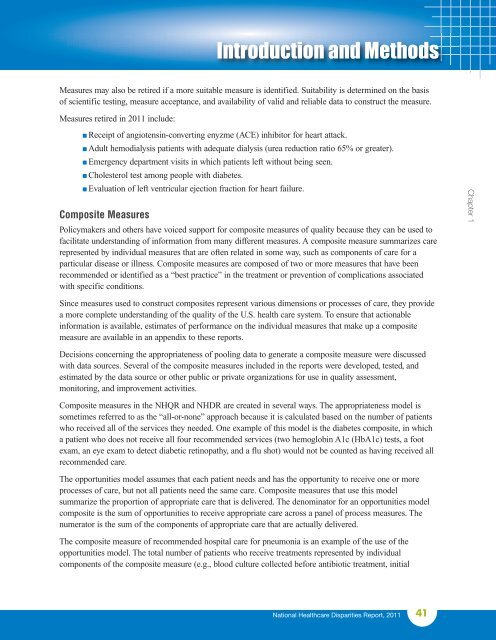National Healthcare Disparities Report - LDI Health Economist
National Healthcare Disparities Report - LDI Health Economist
National Healthcare Disparities Report - LDI Health Economist
Create successful ePaper yourself
Turn your PDF publications into a flip-book with our unique Google optimized e-Paper software.
Introduction and Methods<br />
Measures may also be retired if a more suitable measure is identified. Suitability is determined on the basis<br />
of scientific testing, measure acceptance, and availability of valid and reliable data to construct the measure.<br />
Measures retired in 2011 include:<br />
n Receipt of angiotensin-converting enyzme (ACE) inhibitor for heart attack.<br />
n Adult hemodialysis patients with adequate dialysis (urea reduction ratio 65% or greater).<br />
n Emergency department visits in which patients left without being seen.<br />
n Cholesterol test among people with diabetes.<br />
n Evaluation of left ventricular ejection fraction for heart failure.<br />
Composite Measures<br />
Policymakers and others have voiced support for composite measures of quality because they can be used to<br />
facilitate understanding of information from many different measures. A composite measure summarizes care<br />
represented by individual measures that are often related in some way, such as components of care for a<br />
particular disease or illness. Composite measures are composed of two or more measures that have been<br />
recommended or identified as a “best practice” in the treatment or prevention of complications associated<br />
with specific conditions.<br />
Chapter 1<br />
Since measures used to construct composites represent various dimensions or processes of care, they provide<br />
a more complete understanding of the quality of the U.S. health care system. To ensure that actionable<br />
information is available, estimates of performance on the individual measures that make up a composite<br />
measure are available in an appendix to these reports.<br />
Decisions concerning the appropriateness of pooling data to generate a composite measure were discussed<br />
with data sources. Several of the composite measures included in the reports were developed, tested, and<br />
estimated by the data source or other public or private organizations for use in quality assessment,<br />
monitoring, and improvement activities.<br />
Composite measures in the NHQR and NHDR are created in several ways. The appropriateness model is<br />
sometimes referred to as the “all-or-none” approach because it is calculated based on the number of patients<br />
who received all of the services they needed. One example of this model is the diabetes composite, in which<br />
a patient who does not receive all four recommended services (two hemoglobin A1c (HbA1c) tests, a foot<br />
exam, an eye exam to detect diabetic retinopathy, and a flu shot) would not be counted as having received all<br />
recommended care.<br />
The opportunities model assumes that each patient needs and has the opportunity to receive one or more<br />
processes of care, but not all patients need the same care. Composite measures that use this model<br />
summarize the proportion of appropriate care that is delivered. The denominator for an opportunities model<br />
composite is the sum of opportunities to receive appropriate care across a panel of process measures. The<br />
numerator is the sum of the components of appropriate care that are actually delivered.<br />
The composite measure of recommended hospital care for pneumonia is an example of the use of the<br />
opportunities model. The total number of patients who receive treatments represented by individual<br />
components of the composite measure (e.g., blood culture collected before antibiotic treatment, initial<br />
<strong>National</strong> <strong><strong>Health</strong>care</strong> <strong>Disparities</strong> <strong>Report</strong>, 2011<br />
41

















